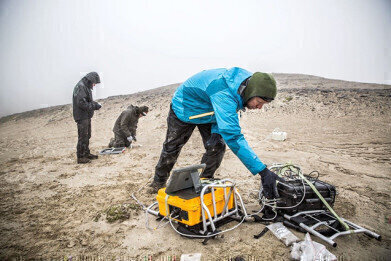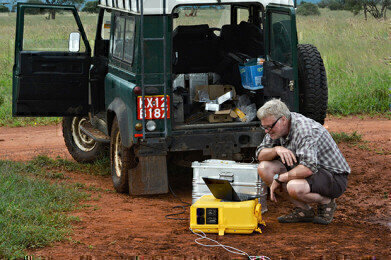Industrial emissions
A closer look at greenhouse gas emissions and air pollution.
Jan 12 2022
Since 1983, Enviro Technology Services (ET) have been providing clients with the measurement technology that underpins national air quality monitoring networks and enables scientists to conduct cutting-edge research into greenhouse gas emissions and fluxes. In this article, ET’s Managing Director, Duncan Mounsor discusses the linkages and associations between greenhouse gases and air pollution, and why a more holistic approach to measurements is important.
In a great many cases, air pollution and greenhouse gas emissions are inextricably linked.
Cut down on fossil fuel combustion and emissions of carbon dioxide (CO2) will fall, along with the direct emissions of trace gases such as oxides of nitrogen (NOx) and sulphur dioxide (SO2) as well as air pollution from (PM) particulate matter and black carbon (BC).
Whilst the combustion of any type of fossil fuel will always result in CO2 emissions, the amount and type of air pollution created will depend on the type, source and quality of the fuel being burnt. Natural gas being relatively clean, with coal and heavy fuel oil being particularly dirty.
And as agreed at COP26, whilst many nations have accelerated their plans to shift away from coal during this decade, some of the most populous and largest coal producing nations have pushed this back as far as 2070, meaning billions of tonnes of CO2 will continue to be emitted unless massive strides can be made in carbon capture and sequestration (CCS) technologies and the implementation of them.
Heavy fuel oil (HFO), or ‘bunker fuel’ has primarily been used to fuel the engines of global shipping, and whilst the International Maritime Organisation (IMO) now legislates on ship exhaust emissions, forcing a switch to cleaner, lower sulphur content fuel oil (and in some cases the fitting of pollution abatement technology), worldwide shipping represents one of the largest, if not the largest, anthropogenic sources of SO2 emissions. And let’s not forget SO2 from coal combustion and the use of abundant, cheap and often high sulphur content coal used in power stations in developing (and some ‘developed’) countries, and those with less stringent air pollution legislation and regulation.
Unabated emissions from coal and fuel oil combustion also leads to PM and BC pollution, with black carbon significantly changing the albedo where it deposits in the north and south poles, contributing to radiative forcing and global warming.
We all know that despite the small downward blip in 2020 caused by the Covid-19 pandemic, CO2 emissions are higher than they have ever been - approximately 35 billion tonnes per year, with the 2020 global average concentration of CO2 being 412.5 parts per million (ppm), more than one and half times what it was before the industrial revolution.
CO2 persists in the atmosphere for between 300-1000 years, all the while trapping heat and warming the planet. Whilst not the only (or most damaging) greenhouse gas, it is by far the most abundant and is responsible for almost 75% of the total. It is the greenhouse gas that all others are measured against (CO2e) with the ‘e’ standing for ‘equivalent’. As the primary and most abundant greenhouse gas, it is ascribed a Direct Global Warming Potential (DGWP) of 1.
Methane (CH4) is the next biggest greenhouse gas in terms of emissions (17% of the total). The most recent estimates suggest annual global emissions of CH4 of some 570 million tonnes (CO2e), but it is between 28-36 times more damaging than CO2 in terms of its DGWP.
Methane persists in the atmosphere for around 12 years. Approximately 40% of CH4 emissions are from natural sources (i.e. wetlands), but 60% come from anthropogenic sources, the largest of which being agriculture which is thought contributes to over 25% of the total.
Coming in in 3rd place is nitrous oxide (N2O) or laughing gas (6% of the total). However, it’s no joke that this ‘forgotten’ greenhouse gas has a DGWP some 300 times more damaging than CO2 in its ability to trap heat, and it persists in the atmosphere for around 114 years. N2O emissions are on the increase with some 3 million tonnes (CO2e) emitted annually. By far the largest source of N2O comes from soil gas emissions caused by a complex set of nitrogen compound reactions and microbial activity as a direct consequence of excessive application of ammonia fertiliser and intensive agriculture. Ammonia (NH3) itself, through a series of atmospheric nitrogen cycle reactions and the formation of ammonium nitrate, is now considered to be a major factor in the formation of PM2.5 particulate pollution, perhaps the most dangerous modern-day pollutant of the lot.
With 78% of our atmosphere consisting of nitrogen, NOx is always going to be a by-product of fossil fuel combustion where ‘air’ is used for the oxygen required for combustion. Whilst great strides have been taken with ‘low-NOx’ and ‘clean-burn’ engine technology, coupled with the catalytic converters fitted to our petrol-powered cars, the massive push to diesel vehicles in the 2000s has been partly responsible for levels of nitrogen dioxide (NO2) creeping up, and in many locations seeing annual NO2 limit values being exceeded as a consequence. And whilst the high temperature diesel particulate filters (DPFs) fitted to exhaust systems have done a great job in reducing PM10 and PM2.5 particulate matter emissions from exhaust pipes, an unintentional and underestimated consequence of these heated devices, is their ability to oxidise NO to NO2 contributing to yet another pollutant that has long been known to be dangerous to human health.
And NOx and NO2 along with volatile organic compounds (VOCs) - from natural and anthropogenic emissions - along with warm temperatures and sunlight, lead to yet another significant and dangerous air pollutant, ozone (O3).
In summary, our atmosphere is a dynamic, life-giving (and life-protecting) ‘chemistry set’ of cyclic chemical reactions, with greenhouse gases and air pollution being linked in more ways than are immediately obvious.
Whether given the moniker ‘greenhouse gas’ or ‘air pollutant,’ it is fundamentally important that we continue to measure these gases and particles as accurately and precisely as we can and expand our measurement networks to include ‘new’ compounds of interest as their significance and importance comes to light.
As Lord Kelvin once famously said; ‘to measure is to know’ and I’d like to expand on this and conclude by saying ‘to measure better is to know better’.
Duncan Mounsor (December 2021).
Digital Edition
IET 35.2 March
April 2025
Air Monitoring - Probe Sampling in Hazardous Areas Under Extreme Conditions - New, Game-Changing Sensor for Methane Emissions - Blue Sky Thinking: a 50-year Retrospective on Technological Prog...
View all digital editions
Events
May 10 2025 Karachi, Pakistan
May 11 2025 Vienna, Austria
May 11 2025 Seoul, South Korea
Salon Analyse Industrielle & Instrumentation
May 14 2025 Paris, France
May 15 2025 Istanbul, Turkey











_(4427399123)-(2).jpg)












